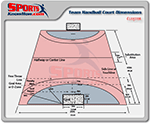Team Handball Court Dimensions Diagram
The main dimensions and markings for the Team Handball Court consist of the following major elements.
Court and Lines:
The indoor court has a hard surface. All lines are 5 centimeters (2 inches) thick; the only exception is the goal line, which is 8 centimeters (3 inches) thick. All lines must be prominent and of the same color.
Sidelines and Goal Lines:
The overall size of the court is 40 meters (44 yards) long by 20 meters (22 yards) wide. This is much bigger than a standard basketball court. The longer outer boundaries of the court are called sidelines or touchlines. The shorter boundaries are referred to as Goal Lines or End Lines.
A distance of 1 meter (1 yard) outside the court in all four directions should be free of obstacles to allow for free throwing of the ball and safety to the players.
Halfway or Center Line:
This is a line parallel to the goal lines and equidistant from both. There is a point marked at the center of the halfway line; the game is started from there at the beginning and re-started from the same point after halftime and after any goal is scored.
Free-throw Line (9 Meters):
The Free-throw line is a dashed arc outside the D-zone. Its furthest point is 9 meters (9.8 yards) from the outer goal line. After an attacking team is fouled inside the Free-throw line, players resume the game from this line.
Penalty Mark (7 Meter Mark):
The Penalty Mark is 7 meters (7.6 yards) in front of the goal line and is 1 meter (1 yard) wide. The Penalty mark is where a player of the opponents’ team takes a penalty throw.
Goal Area / Crease / D-Zone (6 Meters):
The goal is surrounded by a D-shaped area formed of two quarter-circles, each with a radius of 6 meters (6.5 yards) and using the outer end of the goal post as the center. A short straight line joins the open ends of the two quarter-circles. The only player allowed in the Crease is the goalkeeper defending that goal. This line separates him from all the other players.
Goalkeeper Line (4 Meter Line):
The Goal Keeper line is drawn 4 meters (4.4 yards) away from the goal and centered along the width of the court. That line marks the outermost distance to which the goalkeeper is allowed to go from the goal being defended during a penalty throw.
Goal / Clearance Area:
A goal is centered along each goal line at each end of the court. It is 3 meters (3.2 yards) wide and 2 meters (2.2 yards) tall, bolted to the wall or to the floor. It is 2 meters (2.2 yards) deep from the goal line to the outside.
Goal posts:
The goal posts and crossbar are made of aluminum or wood, 8 centimeters (3 inches) wide in cross-section. These three rods should be painted in alternate colors that contrast with each other and with the court background to make them visible from all areas of the large court. A common color code should be used for both goals. The net should be fixed to the posts and crossbar such that a ball thrown into it should not pass or leave the goal.
Substitution area:
The substitution area is centered along one sideline of the court, extending 4.5 meters (5 yards) each side from the halfway line. Any player leaving or entering the field must do so from there.
Governing International Federation:
Such as with most international sports, there is a governing body for team handball, That body is called the International Handball Federation (IHF). The Fedaration standardizes both the rules of the game and the court dimensions for a team handball court. For more information, see their website here: /
